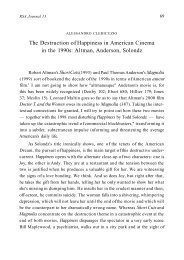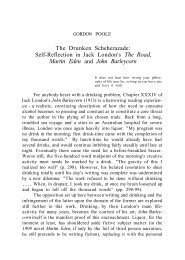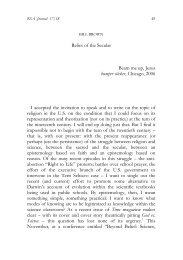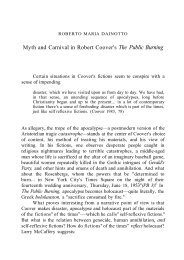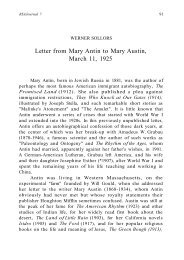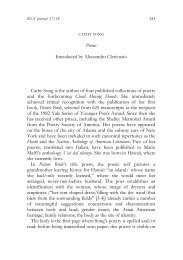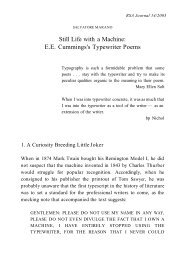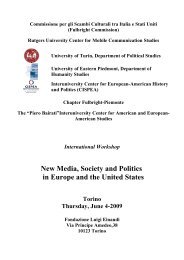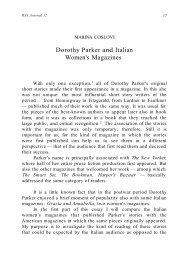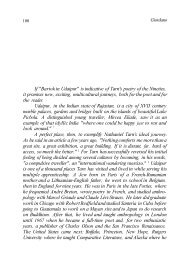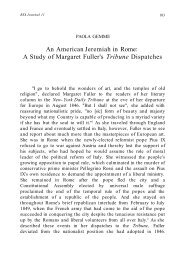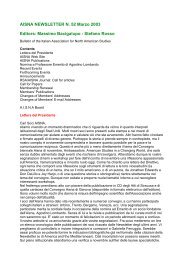"Empty Silences": T.S. Eliot and Eugenio Montale - aisna
"Empty Silences": T.S. Eliot and Eugenio Montale - aisna
"Empty Silences": T.S. Eliot and Eugenio Montale - aisna
Create successful ePaper yourself
Turn your PDF publications into a flip-book with our unique Google optimized e-Paper software.
RSA Journal 14/2003<br />
STEFANO MARIA CASELLA<br />
"<strong>Empty</strong> Silences":<br />
T.S. <strong>Eliot</strong> <strong>and</strong> <strong>Eugenio</strong> <strong>Montale</strong><br />
"Silence" Oracoli caldaici, 158<br />
Along the city streets<br />
It is still high tide,<br />
Yet the garrulous waves of life<br />
Shrink <strong>and</strong> divide<br />
With a thous<strong>and</strong> incidents<br />
Vexed <strong>and</strong> debated —<br />
This is the hour for which we waited —<br />
This is the ultimate hour<br />
When life is justified.<br />
The seas of experience<br />
That were so broad <strong>and</strong> deep,<br />
So immediate <strong>and</strong> steep,<br />
Are suddenly still.<br />
You may say what you will,<br />
At such peace I am terrified.<br />
There is nothing else beside. 1<br />
"Forse un mattino"<br />
Forse un mattino <strong>and</strong><strong>and</strong>o in un'aria di vetro,<br />
arida, rivolgendomi, vedrò compirsi il miracolo:<br />
il nulla alle mie spalle, il vuoto dietro<br />
di me, con un terrore di ubriaco.<br />
Poi come s'uno schermo, s'accarnperanno di gitto<br />
alberi case colli per l'inganno consueto.<br />
Ma sarà troppo tardi; ed io me n'<strong>and</strong>ro zitto<br />
tra gli uomini che non si voltano, col mio segreto. 2
68 Stefano Maria Casella<br />
It might seem superfluous to repeat again Mario Praz's formula in his<br />
earliest comparison between T.S.<strong>Eliot</strong> <strong>and</strong> <strong>Eugenio</strong> <strong>Montale</strong>: "Parallels in<br />
history, though apt to be misleading, offer a tempting playground for<br />
speculation" (244), as so much has been written about this topic since<br />
1933: books, essays, not to mention dissertations ("let some thesis-writer<br />
have the satisfaction of discovering ..." (109), the eighty years old Pound<br />
mused though in other circumstances — that is about his 1919 French<br />
tour together with T.S.<strong>Eliot</strong>. But it is the very word "speculation" which,<br />
once more, gives the clue <strong>and</strong> the idea, <strong>and</strong> again arouses the curiosity<br />
about another parallel <strong>and</strong> comparative reading, even though limited to<br />
what might be called a marginal gloss on a topic scarcely or not at all<br />
dealt with before. And the "speculation" (speculum) gives back more or less<br />
different images, <strong>and</strong> marks the similar traits of the reflected images of<br />
these two poems. Furthermore, the privileged perspective ("tempting<br />
playground") of the reader-critic offers a further opportunity to attempt<br />
a side-by-side reading, under the urge of further explorations, especially<br />
after the posthumous <strong>and</strong> long-delayed publication of <strong>Eliot</strong>'s earliest<br />
poetic drafts (Inventions of the March Hare, 1996): a collection which offers<br />
readers <strong>and</strong> scholars some fifty "new" poems, <strong>and</strong> the possibility of<br />
further comparisons (or, better, to antedate such comparisons)<br />
notwithst<strong>and</strong>ing the scarce <strong>and</strong> often distorted attention (or, perhaps,<br />
because of it) that has been paid to such poems. 3<br />
Two texts deserve special discussion: <strong>Eliot</strong>'s previously unpublished<br />
(but not unknown) "Silence," dating 1910, <strong>and</strong> <strong>Montale</strong>'s most famous<br />
"ossa breve," titled "Forse un mattino <strong>and</strong><strong>and</strong>o in un'aria di vetro,"<br />
which belongs to his poetic debut, Ossi di Seppia (1926). These two poems<br />
record a privileged epiphanic moment, an extraordinary experience, a<br />
kind of hallucinated <strong>and</strong> much-looked-for flash of vision <strong>and</strong> dénouement<br />
or, better, small miracle <strong>and</strong> partial revelation, a "moment in <strong>and</strong> out of<br />
time" typical both of the young poet of St. Louis <strong>and</strong> of his younger<br />
Genoese counterpart. It is well known that the two writers were
"<strong>Empty</strong> Silences": T.S. <strong>Eliot</strong> <strong>and</strong> <strong>Eugenio</strong> <strong>Montale</strong><br />
particularly attracted by spiritual <strong>and</strong> quasi-mystical experience. Suffice<br />
it to recall here a passage from a letter of the twenty-one-year-old soldier<br />
<strong>Eugenio</strong> <strong>Montale</strong> to his sister Marianna, from the Infantry School of<br />
Parma: "Io sono un amico dell'invisibile e non faccio conto di ciò che si<br />
fa sentire e non si mostra; e non credo e non posso credere a tutto quello<br />
che si tocca e che si vede" (Quaderno 72) . Even more meaningful is the<br />
famous statement in "Intervista Immaginaria" (1946), a flash-back of his<br />
juvenile experiences <strong>and</strong> "quest":<br />
Mi pareva di vivere sotto una campana di vetro, eppure sentivo di essere<br />
vicino a qualcosa di essenziale. Un velo sottile, un filo appena mi separava<br />
dal quid definitive. l'espressione assoluta sarebbe stata la rottura di quel<br />
velo, di quel filo: una esplosione, la fine dell'inganno del mondo come<br />
rappresentazione. 4<br />
There is a clear reference to Schopenhauer, by way of the title "mondo<br />
come rappresentazione." Other philosophical <strong>and</strong> literary influences<br />
during <strong>Montale</strong>'s "Lehrjahre" work in this direction: his omnivorous<br />
daily readings at the Berio <strong>and</strong> University Libraries in Genoa (see<br />
Quaderno), his interest in the sceptical philosophy of Giuseppe Rensi <strong>and</strong><br />
Arthur Schopenhauer. 5<br />
In his turn <strong>Eliot</strong> — apart from his familiar heritage, the cultural<br />
tradition of New Engl<strong>and</strong>, <strong>and</strong> that particular shade of scepticism that he<br />
himself defined as "the Boston doubt" (Davidson 25) — "said that his<br />
mind was naturally inclined to the metaphysical, <strong>and</strong> any mystical<br />
experience which put him in touch with another kind of existence would<br />
be treasured <strong>and</strong> made much of' (Gordon 35). Then, in a kind of self<br />
projection into an animal-like character ("And I must borrow every<br />
changing shape / To find expression ... dance, dance, / Like a dancing<br />
bear, / Cry like a parrot, chatter like an ape" of the finale of "Portrait of a<br />
Lady" — CPP 21), that is in the wriggling "Eeldrop" of "Eeldrop <strong>and</strong><br />
69
70 Stefano Maria Casella<br />
Appleplex," the poet defined the former of the two characters of the title<br />
(i.e. his own spokesman) as "a sceptic with a taste for mysticism"<br />
("Eeldrop" 7). The common denominator represented by the sceptical<br />
attitude of both poets is remarkable.<br />
A year after the composition of "Silence," <strong>Eliot</strong> begun reading <strong>and</strong><br />
studying Evelyn Underhill's Mysticism (published in 1911), a treatise<br />
which was destined to remain one of the fundamental guides on the<br />
theory, phenomenology <strong>and</strong> practice of the mystical experience<br />
throughout his life. 6<br />
In other words, for both poets <strong>and</strong> "sub specie spiriti," in their<br />
beginning was already inscribed their end. However, it is not so much the<br />
biographical aspects that will be considered in these notes, but the<br />
striking analogies between these two brief, suddenly visionary texts<br />
marked by "clear visual images" <strong>and</strong> built as tightly textured poetical<br />
artefacts.<br />
Chronology <strong>and</strong> Influence<br />
<strong>Eliot</strong> obviously deserves the chronological priority, "Silence" having been<br />
h<strong>and</strong>written, as a matter of fact, on the notebook titled by its author<br />
"Inventions of the March Hare" — a jotter that the young <strong>Eliot</strong> bought in<br />
a stationery shop of Gloucester, Mass., <strong>and</strong> that partially followed the<br />
destiny of the much more famous "Waste L<strong>and</strong> manuscript" (Inventions<br />
XI-XV, 124-126). <strong>Montale</strong>'s "Forse un mattino..." was composed in July<br />
1923, that is more than ten years later, <strong>and</strong> belongs to a couple of<br />
manuscripts (each containing a few other poems) dedicated respectively<br />
to Francesco <strong>and</strong> to Bianca Messina (Arvigo 124). But the similarities in<br />
theme <strong>and</strong> imagery are evident, clear, <strong>and</strong> quite striking, even though the<br />
conclusion seems to point towards two different directions. Nonetheless<br />
both writers remained almost totally coherent, in their entire creative<br />
parable, to those early formulations, not so much as stylistic <strong>and</strong> formal
"<strong>Empty</strong> Silences": T.S. <strong>Eliot</strong> <strong>and</strong> <strong>Eugenio</strong> <strong>Montale</strong><br />
aspects are concerned, but as regards poetical images, ideas, mental<br />
representations, <strong>and</strong> philosophical concepts. In <strong>Eliot</strong>, as anticipated<br />
above, the main influence was that of his initial scepticism coupled with<br />
a strong bent towards mysticism: for <strong>Eugenio</strong> <strong>Montale</strong>, apart the above<br />
mentioned sceptics like G. Rensi <strong>and</strong> A. Schopenhauer, we should add<br />
Šcestov (<strong>Montale</strong>, Poesia 564), the Russian novelists of the nineteenth<br />
century, in particular Tolstoi <strong>and</strong> Dostoievskji (Pasquini 28), <strong>and</strong>, as<br />
regards the brief poem we are discussing, a meaningful passage from the<br />
essay "L'Umorismo" by Luigi Pir<strong>and</strong>ello (Pasquini 29; Marchese 182;<br />
Arvigo 125).<br />
A Brief Critical Survey<br />
I) T.S.<strong>Eliot</strong><br />
It has been anticipated that "Silence" had already been mentioned in<br />
<strong>Eliot</strong>'s biographies <strong>and</strong> in a few strongly characterized critical readings of<br />
his poetry, focused on the spiritual experiences of the young American<br />
poet. Lyndall Gordon begins the second chapter ("New Engl<strong>and</strong><br />
Student") of her 1977 biography with a reconstruction of the scenery — or<br />
"occasion" (to use a <strong>Montale</strong> expression) of the poem:<br />
About the same time that <strong>Eliot</strong> graduated from Harvard College, while<br />
walking one day in Boston, he saw the streets suddenly shrink <strong>and</strong> divide.<br />
His everyday preoccupations, his past, all the claims of the future fell away<br />
<strong>and</strong> he was enfolded in a great silence. In June 1910 he wrote a poem he<br />
never published called "Silence," his first <strong>and</strong> perhaps most lucid<br />
description of the timeless moment ... At the age of twenty-one <strong>Eliot</strong> had<br />
one of those experiences which, he said, many have had only once or twice<br />
in their lives <strong>and</strong> been unable to put into words. "You may call it<br />
communion with the Divine or you may call it temporary crystallization of<br />
the mind," he said on another occasion ... In "Silence" <strong>Eliot</strong> declared that<br />
this was the moment for which he had waited. Silence came to a prepared<br />
mind..." (15)<br />
71
72 Stefano Maria Casella<br />
Even though the poem is nowadays published, <strong>and</strong> notwithst<strong>and</strong>ing<br />
Christopher Rick's extensive <strong>and</strong> exhaustive commentary (Inventions 124<br />
126), Gordon's precise information remains invaluable. The biographer<br />
critic returns again to the poem in a further reconsideration, concerning<br />
the recurrence of imagery (intertextuality) in <strong>Eliot</strong>'s whole body of<br />
poetry:<br />
"Silence" was the forerunner of later beatific moments in <strong>Eliot</strong>'s work: in<br />
the hyacinth garden "looking into the earth of light, the silence," in the<br />
garden of Burnt Norton where the surface of the pool "glittered out of the<br />
heart of light," in the pulse in the arm "less strong <strong>and</strong> stronger / ... more<br />
distant than stars <strong>and</strong> nearer than the eye." In each case it seems to him<br />
that he has received some kind of message that disperses <strong>and</strong> obliterates<br />
ordinary reality, a message he badly needs to interpret. (35)<br />
Peter Ackroyd, <strong>Eliot</strong>'s other major biographer, stresses another<br />
aspect of this brief poem:<br />
Sometimes this self-absorption seems to be the condition of poetic vision<br />
itself, a "moment out of time" which in the unpublished poem "Silence"<br />
(June 1910) stills the waters of experience <strong>and</strong> creates a terrifying peace<br />
... ["Silence"] the poem of withdrawal. (38, 40)<br />
Very few critics have focused on this early <strong>and</strong> still incomplete vision<br />
of <strong>Eliot</strong>'s: Eloise Knapp Hay disagrees with Lyndall Gordon's point of<br />
view, emphasizing <strong>Eliot</strong>'s preference for Oriental philosophy <strong>and</strong> religion<br />
instead of Christianity:<br />
One of his earliest unpublished poems . . . was a two-stanza poem called<br />
"Silence." Dated "June, 1910," the month when he first went to France<br />
after studying with Babbitt, returning a year later to start his studies in<br />
philosophy, the poem already centers on feelings of recoil from the noisy
"<strong>Empty</strong> Silences": T.S. <strong>Eliot</strong><strong>and</strong> <strong>Eugenio</strong> <strong>Montale</strong><br />
swell of life toward a center of ultimate stillness. I do not read this poem<br />
the way Lyndall Gordon does, as an inclination toward Christianity ...<br />
clearly the Buddhist peace of emptiness <strong>and</strong> negation was already more real<br />
to him than the Christian peace, however terrifying that emptiness seemed<br />
to him at that time. (72)<br />
Knapp Hay seems to think of the poet's own recollection about the<br />
juvenile attraction he felt for the Oriental thought <strong>and</strong> spirituality in his<br />
earlier academic years at Harvard:<br />
Two years spent in the study of Sanskrit under Charles Lanman, <strong>and</strong> a year<br />
in the mazes of Patanjaly's metaphysics under the guidance of James<br />
Woods, left me in a state of enlightened mystification. A good half of the<br />
effort of underst<strong>and</strong>ing what the Indian philosophers were after — <strong>and</strong> their<br />
subtleties make most of the great European philosophers look like<br />
schoolboys — lay in trying to erase from my mind all the categories <strong>and</strong><br />
kinds of distinctions common to European philosophy from the time of the<br />
Greeks. (<strong>Eliot</strong>, Strange Gods 43-44)<br />
Paul Murray, in his important study on <strong>Eliot</strong> <strong>and</strong> mysticism, offers<br />
his own reflection about "Silence": "This quasi-mystical experience of the<br />
Timeless Moment was the first of a number of similar experiences in<br />
<strong>Eliot</strong>'s life, some of which were of course later to be evoked in Four<br />
Quartets" (2). And John T. Mayer, drawing a partial parallel between the<br />
drafts of The Waste L<strong>and</strong> (now in the Facsimile edition), the final version,<br />
<strong>and</strong> "Silence," writes:<br />
Despite <strong>Eliot</strong>'s yearning for vision, which he explored in the city poems<br />
<strong>and</strong> in "So through the evening," he seems not to have experienced the<br />
vision of the mystics, only privileged moments that, like the experience<br />
portrayed in the unpublished 1910 poem "Silence" <strong>and</strong> in The Waste L<strong>and</strong><br />
Hyacinth Garden, are intensely ambiguous. (81)<br />
73
74 Stefano Maria Casella<br />
Finally Donald J. Childs, projecting the young poet's experience of<br />
that morning of June towards his immediately following interest in<br />
mystical experience, assumes that<br />
<strong>Eliot</strong>'s extensive reading in mysticism in the years that followed can be<br />
understood as an attempt to underst<strong>and</strong> his experience of 1910. Certainly<br />
his notes on U nderhill's Mysticism (made some time over the next three or<br />
four years) reveal an interest in determining the legitimacy of visions. (13)<br />
Childs too connects the phenomenon experinced by the young poet to the<br />
analogous moment of revelation / illumination in The Waste L<strong>and</strong>:<br />
... the word "silence" invokes <strong>Eliot</strong>'s poem of the same name written twelve<br />
years before . . . The speaker notes a silence in the middle of a bustling<br />
city. It is a moment for which he has waited — a moment providing through<br />
stillness <strong>and</strong> silence a hint of the ultimate meaning of life. Mixed with the<br />
feeling of peace, however, is the feeling of terror — a terror that comes of the<br />
awareness that nothing else matters beside this silence. (111)<br />
II) <strong>Eugenio</strong> <strong>Montale</strong><br />
<strong>Montale</strong>'s "Forse un mattino..." has received wider attention <strong>and</strong> more<br />
careful analysis by many of his critics throughout the decades: only very<br />
few comments, the most remarkable <strong>and</strong> incisive, will therefore be<br />
quoted here. Marco Forti stresses the close connection (intertextuality)<br />
between this "osso breve" <strong>and</strong> the entire series of twenty-two poems it<br />
belongs to (83). Silvio Ramat considers that "un miracolo così forte e<br />
fondamentale quale si verifica in 'Forse un mattino' non lo ritroveremo<br />
facilmente, forse mai." (50). In the "Festschrift" Letture Montaliane<br />
(1977) we encounter two remarkable interpretations, respectively by<br />
Italo Calvino <strong>and</strong> Edoardo Sanguineti. The former touches some of the
"<strong>Empty</strong> Silences": T.S. <strong>Eliot</strong> <strong>and</strong> <strong>Eugenio</strong> <strong>Montale</strong> 75<br />
key points of this brief lyric: its being a "poesia d'immaginazione e di<br />
pensiero astratti" (38); the peculiar atmosphere of "un'aria di vetro"<br />
("concretezza ... solidità autosufficiente" (38); the theme of the miracle,<br />
so recurrent in <strong>Montale</strong>'s early poetry, <strong>and</strong> the consciouness of the irreality<br />
of the World (39), which brings not so much the author, but at least this<br />
particular text, close to Oriental thought (another bridge between the<br />
Italian <strong>and</strong> the American poet). But perhaps the most original <strong>and</strong> since<br />
then inescapable contribution offered by Calvino consists in a series of<br />
profound remarks on the theme of space, that space that opens before <strong>and</strong><br />
behind the speaker ("percezione visiva e appropriazione dello spazio"— 40).<br />
Very aptly Calvino refers to Merleau-Ponty's Phénoménologie de la perception<br />
as an suitable interpretative key for the particular atmosphere of the lyric,<br />
<strong>and</strong> to Jorge Louis Borges' Zoologia fantastica as regards the concept (<strong>and</strong><br />
"mythology") of the "hide behind." He finally stresses the poem's<br />
modernity as regards the image of the "schermo" (deriving form the<br />
language <strong>and</strong> technique of cinema) instead of the traditional "theatrum<br />
mundi" metaphor (44).<br />
Edoardo Sanguineti in turn compares <strong>Montale</strong>'s poem with a passage<br />
of Lev Tolstoi on his adolescence, on the theme of nothingness (50). In<br />
Accertamenti montaliani Giorgio Orelli offers a phonic, musical, <strong>and</strong><br />
literary-intertextual analysis of this "osso breve" (11-15).<br />
From a slightly different perspective Ettore Bonora gives his<br />
interpretation of the "event" of this brief lyric:<br />
I versi con la loro ampiezza conferiscono al prodigio immaginato dal poeta<br />
la naturalezza dei fatti realmente accaduti. Eppure l'evento al quale il poeta<br />
pensa è agghiacciante, come puo esserlo il senso del vuoto e del nulla;<br />
qu<strong>and</strong>o poi il miracolo cessa, si fa più profonda la sofferenza di una<br />
solitudine che non può in nessun modo spezzarsi, perché, al riapparire dei<br />
segni della vita, chi ha conosciuto l' orrore del vuoto deve tenerlo dentro di<br />
sé come un segreto. (159)
76 Stefano Maria Casella<br />
The critical readings of the 1980s nd 1990s almost invariably refer<br />
to Italo Calvino's acute notes, <strong>and</strong> develop further suggestions. Emilio<br />
Pasquini stresses the link between the suspended atmosphere of "Forse un<br />
mattino..." <strong>and</strong> the famous lines in "I Limoni" (27 -28):<br />
Vedi, in questi silenzi in cui le cose<br />
s'abb<strong>and</strong>onano e sembrano vicine a tradire il loro ultimo segreto,<br />
talora ci si aspetta di scoprire uno sbaglio di Natura,<br />
il punto morto del mondo, l'anello che non tiene,<br />
il filo da disbrogliare che finalmente ci metta<br />
nel mezzo di una veri tà.<br />
(The word "silenzi" recalls again, at a distance, <strong>Eliot</strong>'s title.)<br />
Franco Croce also establishes a connection between the two poems:<br />
L' approfondimento della tematica dei Limoni è ancora più evidente in un<br />
altro Osso breve, Forse un mattino... Qui la scoperta del "vuoto" dietro le<br />
"spalle" (in qualche modo analoga al tema del "punto morto del mondo" in<br />
Limoni) non è più una scoperta consolante, che addirittura porti, come nei<br />
Limoni, a vagheggiare idillicamente "in ogni ombra umana che si allontana /<br />
qualche disturbata Divinità." Si tratta, si, di un "miracolo" ma vissuto con<br />
drammaticità: "con un terrore d'ubriaco." Ma qu<strong>and</strong>o la trappola del reale<br />
riprende, il privilegio di distinguersi dagli "uomini che non si voltano"<br />
suona anche come una condanna..." (19-20)<br />
Angelo Marchese, in his multifaceted book on the Ligurian poet<br />
Amico dell'invisibile, returns several times to this short lyric, which<br />
represents "1'epifania negativa del miracolo ... e il trucco necessario ...<br />
del mondo come rappresentazione" (12). He then coins a felicitous<br />
formula to define this particular context: "lo scacco di Arsenio," which<br />
sums up all the uncertainties, doubts <strong>and</strong> failures of the most famous<br />
character of <strong>Montale</strong>'s early poetry, especially in this
"<strong>Empty</strong> Silences": T.S. <strong>Eliot</strong> <strong>and</strong> <strong>Eugenio</strong> <strong>Montale</strong><br />
epifania drammatica di un antimiracolo, cioè di un miracolo negativo. . .<br />
Di solito <strong>Montale</strong> ci descrive l'attesa, l'ansia del "miracolo" nelle immagini<br />
famose della "maglia rotta nella rete," dell' "anello che non tiene,"<br />
implicanti l'anelito all'evasione dalla prigione del cosmo. Qui invece si ha<br />
I'esperienza diretta e traumatica del miracolo negativo, che situa l'uomo tra<br />
il "nulla-vuoto" e l' "inganno consueto" della sedicente realtà ... (16)<br />
As regards this uncommon "anti-miracle," Marchese wonders whether it is<br />
un presagio del mondo autre o della dimensione negativa dell'esistenza<br />
assurda? . . . Il miracolo ha svelato l'essenza ontologica negativa del<br />
mondo e la fenomenologia illusoria delle cose, sigill<strong>and</strong>o senza scampo l'io<br />
nel suo segreto di condanna: l'evento soterico è annullato, anche come<br />
ipotesi. (67)<br />
Towards the conclusion of his study, the critic finally focuses his attention<br />
on the difference <strong>and</strong> distance between the experience of the lonely man<br />
who has "seen," <strong>and</strong> the ignorance of the others:<br />
Questa esperienza isola il poeta col suo "segreto" dagli uomini che non si<br />
voltano verso l'abisso del nulla, gli stessi che non si preoccupano delle loro<br />
ombra stampata su uno scalcinato muro . .. indifferenti e aproblematici,<br />
incapaci di sopportare la verira metafisica (e artistica) ... Un'altra<br />
evidente opposizione del testa è quella tra gli "uomini che non si voltano"<br />
e il poeta, col suo "segreto": come a dire, fra chi non percepisce l'abisso che<br />
è alle sue spalle, la precarietà dell'esistente, e l'intellettuale solitario, l'io<br />
lirico che, per un attimo, è colto dalla vertigine del nulla e barcolla come<br />
un ubriaco. (181, 216)<br />
Up to this point, it seems that the critical dilemma between the<br />
positivity <strong>and</strong>/or negativity (revelation or closure) of such an uncommon<br />
phenomenon remain unsolved. Unless one suggests, as we are doing in<br />
77
78 Stefano Maria Casella<br />
this commentary, the archetype of the "mystes," the initiate, who has<br />
undergone a privileged experience of knowledge, <strong>and</strong> therefore cannot<br />
communicate it to his fellow men who remain in their spiritual<br />
blindness.<br />
Only Angiola Ferraris has gone along this line of interpretation,<br />
discerning in the filigree of "Forse un mattino..." nothing less than the<br />
myth of Orpheus:<br />
Penso, innanzitutto, al gesto del poeta, che <strong>and</strong><strong>and</strong>o si volta indietro e ripete,<br />
così, il movimento dello sguardo di Orfeo, rivolto verso Euridice, il cui nome<br />
esprime, secondo Mallarmé, l'idea del mattino del suo breve incanto ...<br />
Ma lo sguardo di chi si volta, come Orfeo, per avvicinare Euridice, la perde<br />
irrevocabilmente: è il paradosso della parola poetica che non tocca le cose se non<br />
per evocate il silenzio che ne avvolge I'essenza, rendendole inafferrabili. Si svela<br />
così "l'inganno consueto" del mondo come rappresentazione. La vicinanza del<br />
paesaggio che ci è abituale ("alberi case colli") è tale solo in apparenza: in realtà<br />
essa rinvia alIa meditazione dissimulata del linguaggio, dello "schermo" sul<br />
quale le immagini si proiettano staccate da quelle degli oggetti, della loro<br />
immediatezza, che rimane avvolta nel silenzio. Ne deriva il "terrore di<br />
ubriaco," il disorientamento di chi all'improvviso si vede sospeso nell'irrealtà<br />
del vuoto. Rimane la casualità della scoperta ("Forse un mattino <strong>and</strong><strong>and</strong>o..."),<br />
che mette in gioco l' esistenza stessa dell'opera, riconducendola, oltre i confini<br />
segnati dal canto, all'incertezza delle origini, all'incontro, affidato anch'esso al<br />
caso, con il "fantasma che ti salva'': "Se procedi t'imbatti / tu forse nel fantasma<br />
che ti salva." (36-37, italics in text)<br />
This is the right perspective to interpret the otherwise almost ineffable<br />
experience that both poets (<strong>Montale</strong> in particular) try to convey in their<br />
verses. Both their "protagonists" (or "characters" or "alter-egos") have<br />
lived something so particular that it cannot be completely defined<br />
through the means of human words <strong>and</strong> language, so that they are<br />
compelled to recur to mythical allusions (biblical or classical) to try to<br />
speak the ineffable. Numberless are the examples, both in mythology <strong>and</strong>
"<strong>Empty</strong> Silences": T.S. <strong>Eliot</strong> <strong>and</strong> <strong>Eugenio</strong> <strong>Montale</strong><br />
in literature, of the "mystai" who have returned from the underworld <strong>and</strong><br />
cannot express their experience through human language: they must<br />
recur either to universal symbols or metaphors (as in the greatest poets<br />
like Dante), or to inadequate representations, or to nothing but "silence,"<br />
the only available response.<br />
As regards Calvino's brief hint at Merleau-Ponty's treatise on<br />
phenomenology, it seems at least advisable to reconsider some sections of<br />
this study, namely those about the phenomena of perception <strong>and</strong> of<br />
hallucination: apart from the pathological perspective of the French<br />
philosopher (which of course can not be literally applied to the two poets<br />
<strong>and</strong> their extraordinary experiences), it is however striking to read<br />
statements like these: "II me semble que le monde se vit lui-même hors<br />
de moi, comme les paysages absents continuent de se vivre au-delà de<br />
mon champ visuel et comme mon passé s'est vécu autrefois en deçà de<br />
mon present" (385); or still more definitely: "Dans un délire alcoolique,<br />
le sujet qui voit... " etc., <strong>and</strong> "L'alcoolique a surtout des hallucinations<br />
visuelles parce que l'activité délirante trouve dans la vue la possibilité<br />
d'évoquer... " (385,393) — which echo <strong>Montale</strong>'s emystich "con un terrore<br />
da ubriaco." And let us consider the following statements:<br />
L'halluciné ne peut pas entendre ou voir au sens fort de ces mots. Il juge, il croit<br />
voir au entendre, mais il ne voit pas, il n'entend pas en effet ...<br />
L'hallucination n'est pas dans le monde mais 'devant' lui parce que le corps de<br />
l'halluciné a perdu son insertion dans le système des apparences . . . Si les<br />
hallucinations doivent pouvoirêtre possibles, il faut bien qu'à quelque<br />
moment la conscience cesse de savoir ce qu'elle fait, sans quoi elle aurait<br />
conscience de constituer une illusion... (387, 391, 396)<br />
Such statements seem to partially interpret both <strong>Eliot</strong>'s vision in<br />
"Silence," <strong>and</strong> <strong>Montale</strong>'s "miracolo" (or "anti-miracolo") in "Forse un<br />
mattino..."<br />
79
80 Stefano Maria Casella<br />
A Brief Reading<br />
<strong>Eliot</strong>'s poem consists of two stanzas of 7 + 9 lines, marked by quite<br />
laborious rhymes in the first one (ABCBDEE II FGHIILLMM — or BB of<br />
the last couplet, if considered as rhyming at distance with lines 2 <strong>and</strong> 4<br />
of the first stanza). Imperfect rhymes <strong>and</strong> echoes at distance make the<br />
phonic texture still more dense <strong>and</strong> tighter. The opening embodies a<br />
customary variant of the townscapes of <strong>Eliot</strong>'s early poetry, from the<br />
previously unpublished sketches in Inventions of the March Hare ("Fourth<br />
Caprice in Montparnasse," "Interlude in London," "Easter: Sensations of<br />
April," "Prufrock among the Women" <strong>and</strong> "Prufrock's Pervigilium") to<br />
the four memorable "Preludes," "Rhapsody on a Windy Night," "The<br />
Love Song of J. Alfred Prufrock" <strong>and</strong> "Portrait of a Lady," up to the<br />
topography of the "unreal city" in The Waste L<strong>and</strong>, both typical of the poet's<br />
direct experience, <strong>and</strong> deriving from the Symbolists (Baudelairean <strong>and</strong><br />
Laforguean) models as well, together with the metaphor of a seascape<br />
(another favorite "topos" of <strong>Eliot</strong>'s poetry, marked by strong<br />
autobiographical connections, see for example "Marina" <strong>and</strong> the multiple<br />
representations from different perspectives <strong>and</strong> focalizations of the third<br />
Quartet, "The Dry Salvages") to emblematise "life" unfurling in "garrulous<br />
waves" (with "garrulous" from the birdsong semantic domain: another area<br />
of imagery which was to become so important for <strong>Eliot</strong>'s poetry after the<br />
1930s: see for example "Cape Ann," the last of the five "L<strong>and</strong>scapes," <strong>and</strong><br />
again Four Quartets: from the very first movement of "Burnt Norton" I<br />
("Quick, said the bird, find them, find them, I Round the corner... Go, said<br />
the bird... Go, go, go, said the bird," CPP 171, 172) to the finale of "Little<br />
Gidding" V ("Quick now, here, now, always," CPP 198). To further enrich<br />
<strong>and</strong> complicate this stratified cluster, one can not omit the most<br />
outst<strong>and</strong>ing allusion, the Biblical one: the waves that "shrink <strong>and</strong> divide"<br />
as in the episode of Israel's flight from Egypt through the sea "beside Pi<br />
hariroth, before Baal-zephon," when the Lord ordered Moses:
"<strong>Empty</strong> Silences": T.S. <strong>Eliot</strong> <strong>and</strong> <strong>Eugenio</strong> <strong>Montale</strong><br />
But lift thou up thy rod, <strong>and</strong> stretch out thine h<strong>and</strong> over the sea, <strong>and</strong> divide it<br />
... And Moses stretched out his h<strong>and</strong> over the sea; <strong>and</strong> the Lord caused the sea<br />
to go back by a strong east wind all that night, <strong>and</strong> made the sea dry l<strong>and</strong>, <strong>and</strong><br />
the waters were divided. (Exodus 14: 16, 21, our emphasis)<br />
The movements in <strong>Eliot</strong>'s poem seem however less ordered: "with a<br />
thous<strong>and</strong> incidents I Vexed <strong>and</strong> debated" (with "debate" recalling, at least<br />
lexically <strong>and</strong> conceptually, the coeval "First Debate between the Body <strong>and</strong><br />
Soul" <strong>and</strong> "Bacchus <strong>and</strong> Ariadne. 2nd Debate between the Body <strong>and</strong><br />
Soul" also in Inventions of the March Hare). Such a tumultuous <strong>and</strong> frenetic<br />
atmosphere seems to calm down in the second half of the composition<br />
(not unlike in Exodus itself, after Pharao's army drowning, <strong>and</strong> Israel's<br />
celebrations of gratitude in honour of its God) when all is "still-ed,"<br />
finally characterized, as it is, by a strange form of "peace," a peace defined<br />
as terrifying ("at such peace I am terrified") <strong>and</strong> revealing the "nihil"<br />
behind. Noteworthy is the fact that the key-word of the title ("silence")<br />
does not appear at all within the sixteen lines of the poem, but it<br />
evidently informs the whole experience from which the vision derives<br />
(silence being also, by the way, the necessary condition to approach such<br />
an experience).<br />
At the very centre of the poem, the slightly imperfect anaphora<br />
"This is the hour.. .// This is the ultimate hour" functions as a hinge<br />
between the two stanzas, connecting them <strong>and</strong> marking, as it does, both<br />
structurally <strong>and</strong> semantically the importance of the moment. It is the<br />
core of the poem, with its images of "life" <strong>and</strong> metaphorically tumultuous<br />
"seas" ("of experience") suddenly stilled: at this point the poetical voice<br />
addresses a second person (external? or an inner self?) with a kind of final<br />
couplet, kernelling its ultimate sense: "At such peace I am terrified. /<br />
There is nothing else beside." The so-much-longed-for moment of peace<br />
proves therefore both terrifying <strong>and</strong> annihilating. Such is the real critical<br />
(<strong>and</strong> ontological) "overwhelming question" of the poem: does it really<br />
81
82 Stefano Maria Casella<br />
express a moment of visionary experience? The sense of nothingness? The<br />
"horror vacui"? Or a positive moment of "vision"? (or the psychological<br />
<strong>and</strong> spiritual pre-requisite for it?). A final cultural <strong>and</strong> philosophical<br />
allusion is suggested by the word "experience" ("seas of experience"),<br />
inasmuch as in the following years the young university student at<br />
Harvard was to approach the philosophical system of Francis Herbert<br />
Bradley, <strong>and</strong> to write his own dissertation on "Knowledge <strong>and</strong> the<br />
Objects of Experience in the Philosophy of F.H.Bradley." 7<br />
<strong>Montale</strong>'s "Forse un mattino..." pivots on the theme <strong>and</strong> image of<br />
the antithesis between deceptive appearance <strong>and</strong> true reality: ("human<br />
kind / Cannot bear very much reality" — <strong>Eliot</strong> had the bird sing in "Burnt<br />
Norton" I, CPP 172). The setting, slightly different from "Silence,"<br />
seems less urban, even though some elements of a village or a city<br />
(indubitably Ligurian) appear in this "vision" ("case" <strong>and</strong> above all<br />
"uomini [che non si voltano]"), <strong>and</strong> an internal echo of a previous "osso<br />
breve," "So l'ora in cui la faccia più impassibile / è traversata da una cruda<br />
smorfia: / s'e svelata per poco una pena invisibile. / Ciò non vede la gente<br />
nell'affollato corso" (Opera 36), anticipates the very theme of "vision vs.<br />
blindness," "the few <strong>and</strong> the many," the "mystes" <strong>and</strong> the ordinary<br />
people. However it seems that the lonely w<strong>and</strong>erer in that crystal clear<br />
morning experiences, like his New Engl<strong>and</strong> counterpart, the sense of<br />
nothingness <strong>and</strong> of terror ("nulla... terrore").<br />
Stylistically, this brief poem consists in eight lines textured in a<br />
flawless rhyme scheme: ABAB 1 / CDCD — typical of <strong>Montale</strong>'s early<br />
poetry, <strong>and</strong> of the twenty-two "ossi brevi" in particular (with a marked<br />
preference, in the case of intentional infringement, for hypermetrical<br />
rhymes) (see Antonello). Whereas in <strong>Eliot</strong>'s poem the experience is given<br />
as already occurred, in <strong>Montale</strong> it is prefigured "sub condicione" of the<br />
hypotetical "[f]orse... ," then followed by four future tenses "vedrà...<br />
s'accamperanno... sarà... <strong>and</strong>rò." Which does not exclude the experience<br />
itself: in other words a rhetorical strategy to project in a more-or-less
"<strong>Empty</strong> Silences": T.S. <strong>Eliot</strong> <strong>and</strong> <strong>Eugenio</strong> <strong>Montale</strong><br />
hypothetic future something already occurred. A most rich texture of<br />
inter-textual imagery in <strong>Montale</strong>'s early poetry (Ossi di Seppia) proves that<br />
this is not a "might be/shall be," but a "has already been" poem of<br />
experience. First of all the theme of the "miracle," of the extraordinary<br />
event breaking the monotonous <strong>and</strong> already pre-fixed chain/course (<strong>and</strong><br />
curse) of events; 8 <strong>and</strong> in parallel the idea/ideal of the impossible dream of<br />
an escape: beyond a wall, through the web of a fishing net. How many<br />
walls <strong>and</strong> nets appear in his early poetry, from the explicit of his very first<br />
lyric "In Limine": "Cerca una maglia rotta nella rete / che ci stringe, tu<br />
balza fuori, fuggi ! " (Opera 5) to many others in Ossi di Seppia. But the<br />
phenomenon in "Forse un mattino... " is indubitably unique, the most<br />
extraordinary <strong>and</strong> memorable of all.<br />
Images, Visions, <strong>and</strong> Structure<br />
It has already been stressed that <strong>Eliot</strong>'s main image is the sea <strong>and</strong> its<br />
tumultuous movements, ebb <strong>and</strong> flow, systole <strong>and</strong> diastole, as a metaphor<br />
of a town(scape) alive with customary daily activity. This activity, all of a<br />
sudden, ceases <strong>and</strong> is suspended into a condition of momentary peace. As<br />
for <strong>Montale</strong>'s scenery, it is more centered on the "locus," both natural <strong>and</strong><br />
humanized: a place like a "theatrum mundi" or, as in Calvino's reading,<br />
like a cinema screen. However, the theatrical metaphor still works,<br />
especially if one thinks of <strong>Eliot</strong>'s lines in "East Coker": "As, in a theatre,<br />
/ The lights are extinguished, for the scene to be changed / With a hollow<br />
rumble of wings, with a movement of darkness on darkness, / And we<br />
know that the hills <strong>and</strong> the trees, the distant panorama / And the bold<br />
imposing facade are all being rolled away —" (CPP 180, emphasis added),<br />
where the words "hills" <strong>and</strong> "trees" recall/repeat precisely <strong>Montale</strong>'s<br />
"alberi...colli." <strong>Montale</strong>'s is a very particular kind ofaubade, not so much<br />
lyric or amorous as in the tradition, but visionary <strong>and</strong> epiphanic —typical,<br />
however, of the Ligurian poet's early compositions (<strong>and</strong> l<strong>and</strong>scapes). The<br />
83
84 Stefano Maria Casella<br />
couple "mattino... aria" represents, in other words, the crystal clear<br />
morning air, <strong>and</strong> its being "di vetro" recalls another typical early image<br />
("etra vetrino" of "Egloga," for example — Opera 72); the "miracolo," as<br />
pointed out above, is a key concept (<strong>and</strong> an eagerly longed for event) of<br />
his early poetry (<strong>and</strong>, above all, his life experience), but the real difference<br />
is what he has seen, the content of such miracle, the epiphany of<br />
nothingness <strong>and</strong> emptiness. Again one can not but recollect lines from a<br />
later <strong>Eliot</strong> text: "The backward look behind the assurance / Of recorded<br />
history, the backward half-look / Over the shoulder, towards the<br />
primitive terror" ("The Dry Salvages" II, CPP 187), where the movement<br />
of looking behind one's shoulders seems to rearrange/reshape <strong>Montale</strong>'s<br />
images of "rivolgendomi ... alle mie spalle ... dietro / di me, con un<br />
terrore ..." <strong>and</strong> the psychological effects are also very similar. Tiziana<br />
Arvigo adds that such an archetypal scene of looking behind oneself<br />
recalls also the Biblical episode (Genesis 19: 26) of Lot's wife transformed<br />
into a salt statue (128).<br />
Again, both poets modulate the theme of nothingness <strong>and</strong> of the<br />
ensuing sense of overwhelming terror: "At such peace I am terrified. /<br />
There is nothing else beside" proclaims <strong>Eliot</strong>; "il nulla alle mie spalle, il<br />
vuoto dietro / di me, con un terrore di ubriaco" records <strong>Montale</strong>. And also<br />
the final image of "silence" is shared by them: the speaker of "Silence"<br />
concludes his brief "narrative" with an implicit declaration of aphasia, of<br />
ineffabilty: "You may say what you will, / At such peace I am terrified. /<br />
There is nothing else beside" — a categorical denial of further speech<br />
(almost like the close of "Cape Ann": "The palaver is finished," CPP 142),<br />
whereas the lonely w<strong>and</strong>erer of "Forse un mattino..." more openly<br />
declares: "Ma sarà troppo tardi, ed io me n'<strong>and</strong>rò zitto / tra gli uomini che<br />
non si voltano, col mio segreto." The secret, the mystery, in both cases (in<br />
both poems), cannot be communicated, being unutterable <strong>and</strong> ineffable:<br />
the "mystes" must keep it to himself, he is bound to silence <strong>and</strong> secrecy.<br />
A further note concerns the spatial arrangement of the events
"<strong>Empty</strong> Silences": T.S. <strong>Eliot</strong> <strong>and</strong> <strong>Eugenio</strong> <strong>Montale</strong><br />
occurring in the two poems: "Silence" seems mainly organized according<br />
to a scheme of "laterality" (apart from the initial "[a]long"), inasmuch as<br />
the waves that "shrink <strong>and</strong> divide" cannot but open at the two<br />
sides—right <strong>and</strong> left—of the speaker/walker (like the Red Sea with Israel:<br />
see above), whereas in "Forse un mattino..." the perception is projected<br />
before <strong>and</strong> behind the protagonist: "<strong>and</strong><strong>and</strong>o... rivolgendomi... aIle mie<br />
spalle... dietro di me ... che non si voltano": two different perspectives,<br />
according to the very different myths the two poems are built upon. Even<br />
though, it must be admitted, in both cases the speaker/w<strong>and</strong>erer goes on<br />
in his direction after the epiphanic moment. And it cannot be otherwise:<br />
the "mystes" must continue his journey, alone (<strong>and</strong> sometimes ahead of<br />
the other people). And again, as regards the spatiality of these two texts,<br />
their perfect architecture should be noted: "Silence" opens with the real<br />
"hic et nunc," to immediately shift to the sea metaphor: "high tide ...<br />
garrulous waves of life / Shrink <strong>and</strong> divide"; then addresses to the more<br />
or less abstract causes: "thous<strong>and</strong> incidents / Vexed <strong>and</strong> debated." At the<br />
centre of the poem, connecting the two stanzas, the so called hinge, "the<br />
hour for which we waited ... the ultimate hour." Then the imagery<br />
returns again to the sea metaphor "seas of experience ... so broad <strong>and</strong><br />
deep / So immediate <strong>and</strong> steep, / Are suddenly still" (counter-movement<br />
with reference to the first half of the poem). And even the causes of<br />
tumult are now appeased: "such peace ... nothing else beside." Imagery<br />
<strong>and</strong> thematic scheme are articulated according to a parallel incremental<br />
pattern: Introduction (1. 1) + A (sea metaphor: 11. 2-4) + B (tumultuous<br />
sea: 11. 5-6) ) + C ("the hour," this particular hour: 11. 7-8) + A1 (sea<br />
metaphor again: 11. 10-12) + B1 (calmed sea: 1. 13) + Conclusion (11. 14<br />
16).<br />
"Forse un mattino..." is organized on a fundamentally similar<br />
pattern (which, besides being spatial, is also "musical" in the<br />
compositional sense of the word), with only one variant. The setting is<br />
again the now <strong>and</strong> here: "mattino... aria di vetro" (1. 1); followed by the<br />
85
86 Stefano Maria Casella<br />
movement: "rivolgendomi" (1. 2); by the extraordinary event: "il<br />
miracolo" (1. 2); by its content/essence: "nulla alle mie spalle ... vuoto<br />
dietro / di me" (11. 3-4) <strong>and</strong> by its effect: "terrore di ubriaco" (1. 4). Then<br />
the repetition of the initial setting, with variation <strong>and</strong> dénouement:<br />
"schermo ... accamperanno ... alberi case colli" (11. 5-6); the counter- or<br />
anti-miracle: "inganno consueto" (1. 6); the reaction of the w<strong>and</strong>erer now<br />
become "mystes'': "io me n'<strong>and</strong>rò zitto ... col mio segreto" (11. 7,8) <strong>and</strong><br />
the counter-movement of line 2 ("rivolgendomi") now projected on the<br />
others, "gli uomini che non si voltano" (1. 8). A series of antithetic<br />
couples: "aria di vetro" vs. "schermo"; "rivolgendomi" vs. "che non si<br />
voltano"; "miracolo" vs. "inganno consueto"; "terrore di ubriaco" vs.<br />
"zitto ... col mio segreto." In an isolated position st<strong>and</strong>s the event itself:<br />
"il nulla alle mie spalle, il vuoto dietro / di me": corresponding, in a<br />
sense, to <strong>Eliot</strong>'s "the hour for which we waited ... the ultimate hour":<br />
again, the climactic moment of the text (its pre-text).<br />
Let us finally consider a noteworthy recurrence of the image of "gli<br />
uomini che non si voltano": a poem in Satura (<strong>Montale</strong>'s fourth poetical<br />
collection, published in 1970, some forty-five years after Ossi di Seppia) is<br />
titled "Gli uomini che si voltano" (without the negative non, in this case),<br />
<strong>and</strong> concludes with a distant reminiscence of that juvenile experience:<br />
... Sono colui<br />
che ha veduto un istante e tanto basta<br />
a chi cammina incolonnato come ora<br />
avviene a noi se siamo ancora in vita<br />
o era inganno crederlo. Si slitta!<br />
(Opera 376)<br />
What an extraordinary flashback! The aged w<strong>and</strong>erer is still pursuing his<br />
quest, he has never forgotten that "moment in <strong>and</strong> out of time," <strong>and</strong> still<br />
wonders whether it was an "inganno" (or, implicitly, a miracle).
"<strong>Empty</strong> Silences": T. S. <strong>Eliot</strong> <strong>and</strong> <strong>Eugenio</strong> <strong>Montale</strong><br />
Provisional Conclusions<br />
<strong>Eliot</strong> seems to have interrupted (or better, momentarily suspended <strong>and</strong><br />
deferred) his spiritual quest, after "Silence": no particular evidence of<br />
such an experience can be found in Prufrock <strong>and</strong> other Observations <strong>and</strong> in<br />
Poems 1920. The case is different with The Waste L<strong>and</strong>, but neither in the<br />
1922 masterpiece nor in the following collections ("The Hollow Men,"<br />
"Ariel Poems," Ash- Wednesday) can the reader find traces of similar<br />
experiences, though the journey has indubitably <strong>and</strong> undeniably begun<br />
with the famous "Let us go then, you <strong>and</strong> I... " of Prufrock's initial<br />
exhortation. It is in fact only in Four Quartets that the long journey of<br />
spiritual experience through the negative way of descent (typical of the<br />
classic initiation <strong>and</strong> of mysticism) is fully accomplished 9 , <strong>Montale</strong>, for<br />
his part, insists in this direction from the very beginning, <strong>and</strong> never<br />
ceases to question the other dimension (<strong>and</strong> the Other) — "senza cessare<br />
di battere alle porte dell'impossibile," as he himself put it (Marchese<br />
221), until his very last collections (Quaderno di Quattro Anni, for<br />
example, <strong>and</strong> Altri Versi). To the former, the answer to his lifelong quest<br />
was perhaps "satisfactory" (as in "Journey of the Magi") if one considers<br />
the ineffable vision of "the fire <strong>and</strong> the rose" in the conclusion of "Little<br />
Gidding" (but how much suffering, "qua homine" <strong>and</strong> "qua poeta" before<br />
reaching that final step: "(Costing not less than everything)": "Little<br />
Gidding" V, CPP 198). To the latter, it seems that the sceptical doubt,<br />
the excruciating "rovello" has never ceased to torture his "spirit<br />
unappeased <strong>and</strong> peregrine" (<strong>Eliot</strong>'s image in "Little Gidding" II, CPP<br />
194). Both of them, however, have gone on with their inimitable<br />
"decenza quotidiana," either among the "crowds flowing over London<br />
Bridge," or "tra gli uomini che non si voltano," or elsewhere <strong>and</strong><br />
everywhere, each with his own silent ineffable secret.<br />
87
88 Stefano Maria Casella<br />
NOTES<br />
1. "Forse un mattino <strong>and</strong><strong>and</strong>o... ," Opera in versi 40.<br />
2. <strong>Eliot</strong>, "Silence," Inventions 18, © Valerie <strong>Eliot</strong>, 1996. All quotations of <strong>Eliot</strong>'s<br />
other poems are from The Complete Poems <strong>and</strong> Plays, <strong>and</strong> are indicated with the<br />
abbreviation CPP followed by page number.<br />
3. Inventions has provoked some narrow-minded polemical attacks because of the<br />
alleged obscenity of <strong>Eliot</strong>'s light verse. See Massimo Bacigalupo's account in<br />
"Thomas Stearns <strong>Eliot</strong>. Invenzioni" (which includes a translation of "Silence" <strong>and</strong><br />
other poems of Inventions) <strong>and</strong> Grotta Byron 84-85.<br />
4. <strong>Montale</strong>, Sulla Poesia 565. A few paragraphs later in the same "Intenzioni<br />
(Intervista immaginaria)," in his recollections of the decade (1929-1939) spent in<br />
Florence when he wrote his second book of poetry, Le occasioni, the poet returns to<br />
the metaphor of the "bell jar" <strong>and</strong> adds: "Del resto, la campana di vetro persisteva<br />
intorno a me, ed ora sapevo ch'essa non si sarebbe mai infranta..." (566).<br />
5. On Giuseppe Rensi's influence on <strong>Montale</strong> see Scarpati 7-32 ("Scepsi e ascesi<br />
all' epoca degli Ossi"). On Schopenhauer's influence on <strong>Eliot</strong> see Habib, passim. Also<br />
Marchese, passim; <strong>and</strong> Barile 40.<br />
6. Not much has been written about the relationship between T.S.<strong>Eliot</strong> <strong>and</strong> Evelyn<br />
Underhill, but it is easy to underst<strong>and</strong> the remarkable influence the English<br />
theologian <strong>and</strong> mystic had on the American poet, if one closely compares the<br />
theoretical writings of the former <strong>and</strong> the poetry of the latter.<br />
7. <strong>Eliot</strong> began studying Bradley's philosophical system between 1911 <strong>and</strong> 1914 at<br />
Harvard, <strong>and</strong> was to write his dissertation on the philosopher at the end of that<br />
period. It is well known that he never defended it, <strong>and</strong> published it only in 1964.<br />
See <strong>Eliot</strong>, Knowledge <strong>and</strong> Experience, "Preface" 9-11.<br />
8. The very word "miracolo" as an extraordinary, longed for <strong>and</strong> soteric event, recurs<br />
only three times in Ossi di Seppia, but its deep meaning is much more pervasive in
"<strong>Empty</strong> Silences": T.S. <strong>Eliot</strong><strong>and</strong> <strong>Eugenio</strong> <strong>Montale</strong><br />
this first poetry book. See Savoca, Concordanza ("miracolo").<br />
9. On a initiatory <strong>and</strong> mystical reading of <strong>Eliot</strong>'s last masterpiece, see Casella,<br />
"L'immaginario iniziatico e mistico."<br />
WORKS CITED<br />
AA.VV. Letture montaliane in occasione dell'80° compleanno delpoeta. Genova: Bozzi, 1977.<br />
Ackroyd, Peter. T. S. <strong>Eliot</strong>. London: Sphere Books/Abacus, 1985.<br />
Antonello, Massimo. La metrica del prima <strong>Montale</strong>: 1915-1927. Pisa- Lucca: Maria<br />
Pacini Fazzi Editore, 1991.<br />
Arvigo, Tiziana. <strong>Montale</strong> "Ossi di Seppia." Guida alla lettura. Roma: Carocci, 2001.<br />
Bacigalupo, Massimo. Grotta Byron. Luoghi e libri. Udine: Campanotto, 2001.<br />
-. "Thomas Stearns <strong>Eliot</strong>. Invenzioni della lepre marzolina." Poesia, 9 (Nov. 1996):<br />
63-68.<br />
Barile, Laura. <strong>Montale</strong> Londra e la Luna. Firenze: Le Lettere, 1998.<br />
Bonora, Ettore. La poesia di <strong>Montale</strong>. Ossi di Seppia. Padova: Liviana, 1982.<br />
Casella, Stefano Maria. "L'immaginario iniziatico e mistico nei Four Quartets di T. S.<br />
<strong>Eliot</strong>." Mosaici di Orizzonti. Societe, immaginari, comunicazione. Ed. Giovanni Michele<br />
Pozzobon. Milano: Franco Angeli, 2005. 91-119.<br />
Childs, DonaldJ. T. S. <strong>Eliot</strong>: Mystic, Son <strong>and</strong> Lover. London: The Athlone Press, 1997.<br />
Croce, Franco. Storia della poesia di <strong>Eugenio</strong> <strong>Montale</strong>. Genova: Costa & Nolan, 1991.<br />
Davidson, Clifford. Baptism the Three Enemies <strong>and</strong> T. S. <strong>Eliot</strong>. Stamford U.K.: Shaun<br />
Tyas, 1999.<br />
Dawson, J.L.; Holl<strong>and</strong>, P.D., McKitterick, D.J. Eds. A Concordance to the Poems <strong>and</strong><br />
Plays of T. S. <strong>Eliot</strong>. Ithaca: Cornell University Press, 1995.<br />
89
90 Stefano Maria Casella<br />
<strong>Eliot</strong>, T. S. After Strange Gods. A Primer ofModern Heresy. New York: Harcourt Brace,<br />
1934.<br />
-. The Complete Poems <strong>and</strong> Plays. London: Faber, 1969 (rep. 1985).<br />
-. "Eeldrop ad Appleplex ." Little Review, 4 (May 1917): 7-11.<br />
-. Inventions of the March Hare. Poems 1909-1917. Ed. Christopher Ricks. London:<br />
Faber, 1996.<br />
-. Knowledge <strong>and</strong> Experience in the Philosophy of F. H. Bradley. New York: Columbia<br />
University Press, 1989.<br />
Ferraris, Angiola. Se il vento. Lettura degli "Ossi di seppia" di <strong>Eugenio</strong> <strong>Montale</strong>. Roma:<br />
Donzelli, 1995.<br />
Forti, Marco. <strong>Eugenio</strong> <strong>Montale</strong>. La poesia, la prosa di fantasia e d'invenzione. Milano:<br />
Mursia, 1973/74.<br />
Gordon, Lyndall. <strong>Eliot</strong>'s Early Years. Oxford: Oxford University Press, 1977.<br />
Habib, Rafey. The Early T. S. <strong>Eliot</strong> <strong>and</strong> Western Philosophy. Cambridge: Cambridge<br />
University Press, 1999.<br />
Hay Knapp, Eloise. T. S. <strong>Eliot</strong>'s Negative Way. Cambridge Ma: Harvard University<br />
Press, 1982.<br />
Marchese, Angelo. Amico dell'invisibile. La personalità e la poesia di <strong>Eugenio</strong> <strong>Montale</strong>.<br />
Torino: S.E.I., 1996.<br />
Mayer,]ohn T. "The Waste L<strong>and</strong> <strong>and</strong> <strong>Eliot</strong>'s Poetry Notebook." T. S. <strong>Eliot</strong>: the Modernist<br />
in History. Ed. Ronald Bush. Cambridge: Cambridge University Press, 1991.67-90.<br />
Marcenaro, Giuseppe; Borragina, Piero. Eds. Una dolcezza inquieta. L'universo poetico<br />
di <strong>Eugenio</strong> <strong>Montale</strong>. Milano: Electa, 1996.<br />
Merleau-Ponty, Maurice. Phénoménologie de la perception. Paris: Gallimard, 1945.<br />
<strong>Montale</strong>, <strong>Eugenio</strong>. L'opera in versi. Ed. Rosanna Bettarini, Gianfranco Contini.<br />
Torino: Einaudi, 1980.<br />
-. Quaderno Genovese. Ed. Laura Barile. Milano: Mondadori, 1983.
"<strong>Empty</strong> Silences": T.S. <strong>Eliot</strong> <strong>and</strong> <strong>Eugenio</strong> <strong>Montale</strong><br />
-. Sulla Poesia. Ed. Marco Forti. Milano: Mondadori, 1975.<br />
Murray, Paul. T. S. <strong>Eliot</strong> <strong>and</strong> Mysticism: The Secret History of "Four Quartets."London:<br />
Macmillan, 1991.<br />
Oracoli caldaici. Ed. Angelo Tonelli. Milano: Coliseum, 1990.<br />
Orelli, Giorgio. Accertamenti montaliani. Bologna: Il Mulino, 1984.<br />
Pasquini, Emilio. La memoria culturale nella poesia di <strong>Eugenio</strong> <strong>Montale</strong>. Modena:<br />
Mucchi, 1991.<br />
Pound, Ezra. "For T. S. E." The Sewanee Review 74 (1966): 109.<br />
Praz, Mario. "T. S. <strong>Eliot</strong> <strong>and</strong> <strong>Eugenio</strong> <strong>Montale</strong>." T. S. <strong>Eliot</strong>. A Symposium. Ed. Richard<br />
March, Thurairjah Tambimuttu. London: Editions Poetry, 1948. 244-248.<br />
Ramat, Silvio. <strong>Montale</strong>. Firenze: Vallecchi, 1965.<br />
Rella, Franco. La cognizione del male. Saba e <strong>Montale</strong>. Roma: Editori Riuniti, 1985.<br />
Savoca, Giuseppe. Concordanza di tutte le poesie di <strong>Eugenio</strong> <strong>Montale</strong>. 2 vols. Firenze:<br />
Olschki, 1987.<br />
Scarpati, Claudio. Sulla cultura di <strong>Montale</strong>. Tre conversazioni. Milano: Vita e Pensiero, 1997.<br />
Underhill, Evelyn. Mysticism. The Development of Humankind's Spiritual Consciousness.<br />
(1911) London: Bracken, 1995.<br />
91



